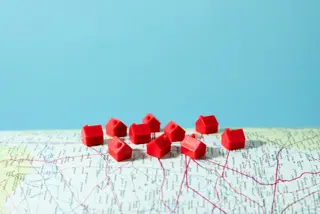Introduction to Suburban Surge in 2025
 The COVID-19 pandemic pushed people toward suburban living, thanks to remote work flexibility, affordability, and a craving for spacious homes. As we head into 2025, this trend isn't slowing down. Suburban areas are transforming into tech-integrated, sustainably designed communities. Let's look at the emerging suburbs leading this change.
The COVID-19 pandemic pushed people toward suburban living, thanks to remote work flexibility, affordability, and a craving for spacious homes. As we head into 2025, this trend isn't slowing down. Suburban areas are transforming into tech-integrated, sustainably designed communities. Let's look at the emerging suburbs leading this change.
Trends Shaping Suburban Real Estate
Hybrid Suburbs and the 15-Minute City Concept
People tired of long commutes are now favoring “hybrid suburbs” mix-use developments where residents can walk to schools, offices, groceries, and parks within 15 minutes. This model, popular worldwide, is booming in U.S. suburbs like Lake Nona, Florida, and Daybreak, Utah. These areas mix residential zones with tech hubs, medical complexes, and green spaces, attracting younger folks who value convenience and sustainability.
Tech Integration and PropTech Advancements
The real estate sector is adopting tech to make homebuying easier. Virtual tours and AI-driven property recommendations pioneered by Zillow and Redfin are reducing reliance on traditional methods. In 2023, 60% of buyers use digital tools. Also, smart homes with solar panels, EV charging stations, and energy-efficient systems are becoming standard, driven by stricter regulations and consumer demand.
Leading Micro-Markets for 2025 Growth
1. Lake Nona, Florida
A prime example of the “15-minute city” model, this suburb near Orlando features:
- Mixed-use districts: Offices, schools, and healthcare hubs
- Tech-powered amenities: Apps for community engagement and hyper-local services
- Green infrastructure: Parks, trails, and LEED-certified buildings
Proximity to IT hubs like Orlando’s tech corridor and improved public transit have driven a 20% increase in mixed-use developments here.
2. Daybreak, Utah
This Salt Lake City suburb showcases sustainable urban planning, offering:
- Walkable neighborhoods: Shops, schools, and medical hubs within short distances
- Single-family homes with tech upgrades: Smart thermostats, remote work-friendly floorplans
- Strong rental demand: Suburbs now account for a growing share of rental markets, especially among millennials.
3. Austin Suburbs (Texas)
Austin’s outskirts are attracting buyers seeking:
- Proximity to tech giants like Dell and IBM
- Affordable housing options compared to urban centers
- Infrastructure projects: Expanded highways and public transport links upcoming
Key Drivers of Suburban Growth
1. Remote Work Permanence Professionals no longer tied to urban offices now prioritize home offices and larger living spaces a trend sped up by hybrid work models.
2. Affordability and Value Suburban properties often have a lower price than urban properties, making them attractive to families and first-time buyers.
3. Infrastructure Investments Municipal projects like upgraded schools, better sewage systems, and parks are enhancing suburban livability, drawing more families away from cities.
Future Outlook: Sustainable and Connected Communities
2025 will see continued investment in PropTech and sustainable housing, with energy-efficient homes making up 35% of new U.S. builds. The 15-minute city concept is expected to expand, especially in areas with strong tech ecosystems, ensuring these suburbs remain competitive against urban markets.
By focusing on connectivity, technology, and sustainability, today’s emerging suburbs are setting a blueprint for tomorrow’s real estate landscape.